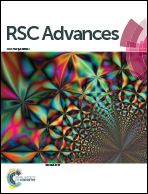Eu3+-doped ionogel-functionalized carbon dot monoliths with bright white photoluminescence†
Abstract
Carbon dots, the new member of carbon materials, have attracted much attention for their alluring optical properties showing intense blue and green emission. Herein, carbon dots were synthesized by the hydrothermal method. Eu3+ β-diketonate complexes with characteristic emission were selected as the lanthanide resource. Silica-based ionogels were prepared by a sol–gel route, the ionic liquids in the ionogels were extracted with acetonitrile, and nano-sized pores among the ionogels were obtained. The carbon dots and Eu3+ complexes were homogeneously entrapped in the ionogels without any devitrification by doping the ionic liquid solution in the silica network of the ionogels. The obtained Eu3+-doped ionogel-functionalized carbon dot monoliths are transparent and uniform with promoted mechanical properties and stability. The carbon dots were confined in the nano-sized pores among the ionogels, resulting in there being a certain distance between the carbon dots, as well as preventing them from aggregating, which contributed to a high photoluminescence. The monoliths emit bright white photoluminescence under UV excitation after various studies of the proportion of carbon dots and Eu3+ complexes. Eu3+-doped ionogel-functionalized carbon dot monoliths provide new potential for applications of carbon nanoparticles in optoelectronic devices.


 Please wait while we load your content...
Please wait while we load your content...